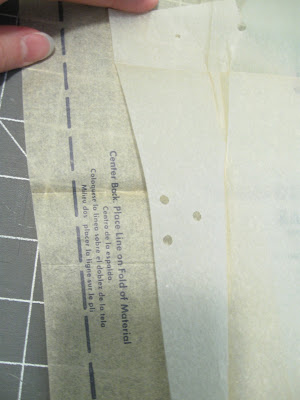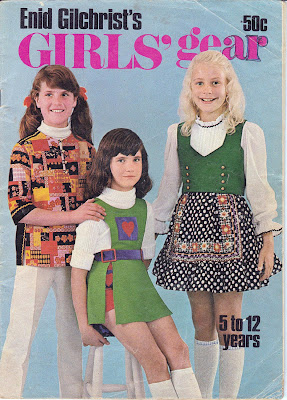We're almost done with our PatternPatter interview series and I hope you have enjoyed seeing all the different patterns and perspectives as I have. Today I wanted to do something a little different. When I first started learning about vintage patterns the word Mod came up a lot. It sounded interesting so I thought why not go to the source of Modness! She even has her very own shop dedicated to Mod! Without further ado, meet Maddie Mod!
"Hi! I’m Maddie Mod, AKA Robin Flinchum, a full time homeschooling mom. When I was about 11 years old (in the mid 1970s), I spent one summer planning my days around the TV Guide and the scheduled reruns of That Girl.
Anne Marie—was there ever anyone more stylish, more perky, good, kind and right? No one I ever saw. And those clothes!
As a child, I didn’t even notice how absurd it was that a struggling actress not only lived alone in a good size apartment in New York City, but that she also had such an amazing wardrobe. But it was the fashion that carried the show, according to Marlo Thomas in a Special Features interview When That Girl was released on DVD (I confess, I own all five seasons). Thomas, who was the executive producer of the show, realized it was completely unrealistic, but she also knew that the clothes were part of what kept her young audience watching the show. So they dressed her in the very height of Mod Era fashion as created by icons such as Mary Quant, Rudi Gernreich, and other cutting edge designers.
Mod (Young Moderns) is one of those rather fluid terms that can be stretched to accommodate a broad range of styles, from the early Beatles and Beatnik straight lines and Go Go boots, to the fringed hippie styles and bell bottoms. As someone who loves almost everything people wore from the early 60s to the mid 70s, I wouldn’t want to try to define Mod, and certainly not to define it too narrowly. But in a nutshell I think of it as the angular rebellion against the hourglass bouffant styles of the 50s. It is certainly built on the A line, on short skirts, taking the eye almost as far away from the waistline as the 1950s took it in.
And then Mod flows and morphs into something different as the hip huggers expand at the hemline into bell bottoms and beads and fringes are everywhere. By the fifth season of That Girl (1970), you can’t find Anne Marie without some kind of fringed something, Indian beadwork jewelry, crocheted belts. It’s a dramatic transition from the mini A lines and matching coats at the beginning of the show (and she loses those adorable bangs, too).
I opened Maddie Mod Patterns as a kind of homage to all of those styles. As my pattern collection grew, I realized those were the ones I loved best, probably because some of them held good memories for me. Some of my favorites include this by Rudi Gernreich
And I love this bedspread dress:
This is one of my very favorites:
for the Mod Era, and these fabulous accessory patterns from the Hippie Era.
What do I wish would go away from the Mod Era? Well, nothing, really. It’s a time in history, a set of events, people, places, looks. Every element combined creates for me a memory that is valuable exactly as it is—dreadfully shapeless dresses, awful furry hats, these things are a joy to me because they belong to and help define the era as much as the styles I love.
But it’s true that you probably won’t find many shapeless dresses or ugly hat patterns in my shop—unless they have fabulous cover art!
When I started selling patterns, I was actually focused on miniature dolls. Human size patterns were sort of an accident I stumbled upon while searching for tiny patterns for my handmade fairy dolls. I came across these patterns and they reminded me of Anne Marie, of my mother, of my older sister in blue gingham bell bottoms. I don’t know what it is about patterns exactly, but once you get hooked, you’re done for! I have boxes and boxes of them now and I love them all, not just the Mod Era but every era! Luckily, I found my home planet at Pattern Patter, our Etsy pattern sellers team, where I discovered I am not the only one with this obsession. I LOVE my team and my teamies!
As for sewing human size clothes, I’m pretty much a novice but I have a stack of patterns waiting to make as my skill level advances. So far, my only advice is to start at the beginning, the very beginning, and take it one step (or stitch) at a time.
Oh the liberating feeling of making your own clothes! You can wear whatever you want! Any era, any style, any fabric you can get your hands on you can wear it, make it in the colors that suit you, sew it to fit your figure. How wonderful is that?!?! I love the freedom in that. And there is tons of help and support on Etsy for beginning sewers, and lots of wonderful blogs such as this one for advice and inspiration. Any kind of pattern you want is available online now. It’s a great time to sew!
OOooh! Feeling Mod anyone? I LOVE that little blue dress! That white Simplicity looks so swishy and cool too. Which is your favorite? If you dear readers are itching to sew up some of these lovely styles please check out Robin's entire stock at Maddie Mod. Thanks for take the time to give us a peek into the Mod world, Robin!
















































